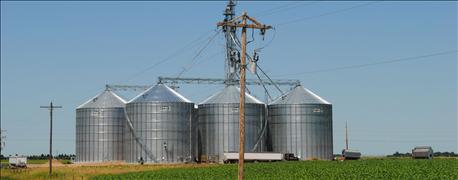
Late fall and early winter are oftentimes when producers are busy moving and marketing grain. So, it is also a time when farmers need to be aware of the dangers of overhead power lines while moving grain-handling equipment.
"We have noticed a rise in contact incidents in recent years, particularly when weather conditions limit the number of days and hours that farmers can be in the field," says LeAnne Doose, public relations director with Southern Power District, based in Grand Island. "Larger equipment heightens the risk all the more, bringing the equipment closer to power lines."

LOOK UP: When moving grain-handling equipment this winter, farmers are encouraged to look up for power lines and give plenty of clearance to avoid contact with them.
The urge to move quickly and get the job done is understandable, but there are no second chances when electricity causes an injury. "Any time saved by ignoring safety precautions is minimal and absolutely not worth the risk," Doose says. "Farmers, as well as hired personnel, need to take the time to look up and navigate safely."
Any contact with power lines carries the potential of a serious or fatal accident. Electricity can arc to the equipment if it comes close to the lines. According to Joel Dagerman, Nebraska Public Power District Transmission and Distribution manager, it is always best to call for help if this happens, and wait until the local electric utility arrives to make sure the line is de-energized. If the power line is energized and you step outside, your body becomes the path and electrocution can happen. "Even if a power line is on the ground, there is still potential for the area nearby to be energized," Dagerman says.
"Stay inside if equipment comes into contact with lines," Doose says. "Do not allow anyone to approach the equipment. Remain in the equipment or vehicle until you receive notification from the power utility that it is safe to exit the unit or vehicle."
If you must exit the vehicle because of fire or imminent risk of fire, the appropriate action is to jump, not step, with both feet hitting the ground at the same time. Jump clear, without touching the vehicle and ground at the same time, and continue to shuffle to safety, keeping both feet together as you leave the area.
Dagerman explained that voltage from a downed line tends to be like the ripples in a pond or lake, so the voltage diminishes the farther out it is from the source, and at no time should anyone touch the equipment and the ground at the same time. Never should the operator simply step out of the vehicle — the person must jump clear.
Use care when raising augers or the bed of a grain truck. It can be difficult to estimate distance, and sometimes a power line is closer than it looks. When moving large equipment or high loads near a power line, always use a spotter to make certain contact is not made with the line.
Always adjust portable augers or elevators to their lowest possible level — under 14 feet ��— before moving or transporting them. Variables like wind, uneven ground, shifting weight or other conditions can combine to create an unexpected result.
Be aware of increased height when loading and transporting larger modern tractors with higher antennas.
Never attempt to raise or move a power line to clear a path. If power lines near your property have sagged over time, call your utility to repair them.
As in any outdoor work, be careful not to raise equipment such as ladders, poles, or rods into power lines. Remember, nonmetallic materials such as lumber, tree limbs, tires, ropes and hay will conduct electricity depending on dampness, dust and dirt contamination.
About the Author(s)
You May Also Like






